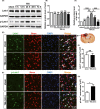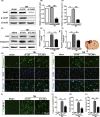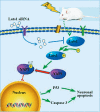Inhibition of Lats1/p-YAP1 pathway mitigates neuronal apoptosis and neurological deficits in a rat model of traumatic brain injury
- PMID: 29488331
- PMCID: PMC6489728
- DOI: 10.1111/cns.12833
Inhibition of Lats1/p-YAP1 pathway mitigates neuronal apoptosis and neurological deficits in a rat model of traumatic brain injury
Abstract
Aims: To investigate the roles of Lats1/p-YAP1 pathway in TBI-induced neuronal apoptosis and neurological deficits in rats.
Results: We found that Lats1 and YAP1 were expressed in cerebral cortex neurons of Sprague-Dawley rats, and the phosphorylation levels of Lats1 and YAP1 in injured regions were significantly increased after TBI. Furthermore, inhibition of Lats1 not only decreased the level of p-YAP1, but also attenuated neuronal apoptosis and neurological impairment.
Conclusions: Our work demonstrates that inhibition of Lats1/p-YAP1 pathway mitigates neuronal apoptosis and neurological deficits in a rat model of TBI.
Keywords: Lats1; YAP1; neurological deficit; neuronal apoptosis; traumatic brain injury.
© 2018 John Wiley & Sons Ltd.
Conflict of interest statement
The authors declare no conflict of interest.
Figures






References
-
- Indraswari F, Wang H, Lei B, et al. Statins improve outcome in murine models of intracranial hemorrhage and traumatic brain injury: a translational approach. J Neurotrauma. 2012;29:1388‐1400. - PubMed
-
- Menon DK, Maas AI. Traumatic brain injury in 2014. Progress, failures and new approaches for TBI research. Nat Rev Neurol. 2015;11:‐72. - PubMed
Publication types
MeSH terms
Substances
LinkOut - more resources
Full Text Sources
Other Literature Sources
Medical

